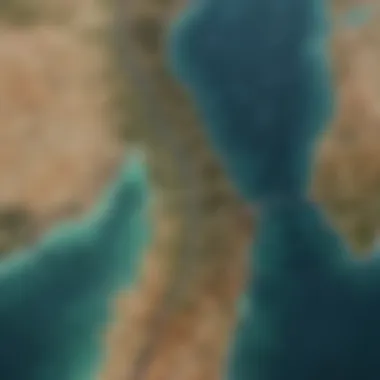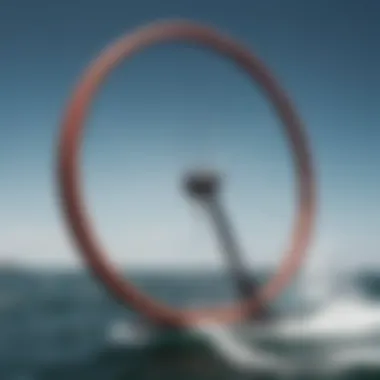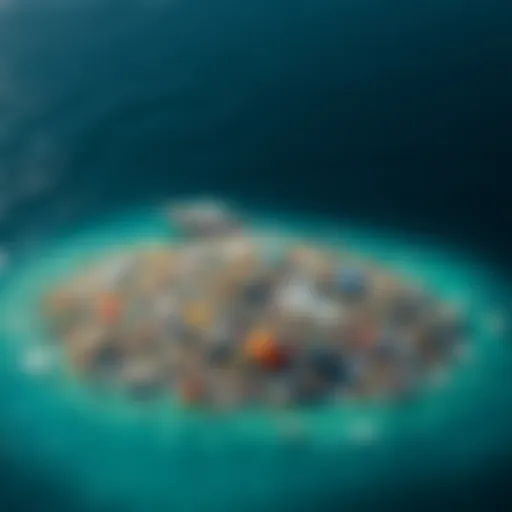Mastering Wind Conditions Maps for Watersports


Intro
Navigating the waters, whether you're on a surfboard, paddleboard, or kiteboard, relies heavily on understanding wind conditions. Every seasoned watersports enthusiast knows that the wind can turn a good day on the water into a baffling experience if it's not correctly gauged. Familiarity with wind conditions maps is essential for anyone looking to optimize their experience and performance on the water. This guide aims to illuminate how these maps work, what to look for, and how to make the most of them in various watersports settings.
When you look at a wind conditions map, you’re not just staring at symbols and colors; you’re interpreting vital information. For novices, this can seem daunting, but understanding how to read these maps is an invaluable skill. Wind patterns can differ greatly by region, time of day, and even season, making the knowledge of how to interpret this information crucial to your safety and enjoyment.
With this understanding, we dive into essential knowledge areas, starting with the gear you need to engage with these wind conditions effectively.
Foreword to Wind Conditions Maps
Wind conditions maps are often the unsung heroes for enthusiasts of watersports. These maps are not just charts filled with numbers and symbols; they are vital tools that help surfers, kitesurfers, paddleboarders, and other water adventurers gauge the air currents that dictate their activities. Understanding these maps can make a significant difference in performance and safety on the water.
Unpacking the Significance
When you look closer, wind conditions maps offer more than mere data. They present insights into how the wind interacts with bodies of water, which can greatly affect your experience on the water. If you know whether you’ll face a gentle breeze or a blustering gale, you can make informed decisions about when and where to partake in your favorite aquatic activities.
For instance, understanding wind direction is crucial. A surfer setting out to catch waves needs to know if the winds will help or hinder their ride. Similarly, a kitesurfer must be aware of gusts that could either lift them gracefully into the air or send them tumbling into the surf.
Key Elements of Wind Conditions Maps
- Wind Speed: Usually represented through gradation colors, a clear visual of wind speed helps users gauge the intensity of the wind.
- Wind Direction: The direction from which the wind blows affects everything from wave formation to ease of maneuverability on paddleboards.
- Local Phenomena: Different areas have unique wind behaviors, influenced by geography or seasonal changes, hence why local knowledge can enhance the use of these maps.
Practical Benefits
Monitoring these elements through wind condition maps allows watersports enthusiasts to plan their outings effectively, minimizing risk and maximizing enjoyment. If you’ve ever been caught out on a day when the wind kicked up unexpectedly, you’ll know the paramount importance of having this knowledge at your fingertips. It not only keeps your adventure exhilarating but also safe.
"A wise sportsman knows his limits, but he’s wiser still when he understands the wind."
In essence, getting familiar with wind conditions maps is like learning the lay of the land before you embark on your journey. They are essential for preparation, providing you with the clarity needed to choose the right time and place for your aquatic endeavors. The winds are as integral to watersports as the waves, and understanding how to navigate this aspect can elevate your overall experience.
The Importance of Wind in Watersports
Understanding the significant role that wind plays in watersports can't be overstated. Wind affects not only the overall experience on the water, but also safety and performance for watersports enthusiasts. Having a good grasp of wind conditions enables surfers, kitesurfers, and paddleboarders to make informed decisions, enhancing their enjoyment and effectiveness.
How Wind Influences Water Dynamics
At its core, wind is a primary driver of water dynamics. When wind blows across the surface of a body of water, it generates waves, which can alter a paddler's or surfer's approach entirely. Waves are formed due to the energy transfer from wind to water. This connection dictates how waves break and their height, both vital aspects for anyone engaging in watersports. A skilled surfer understands that catching a wave requires anticipation of its formation, which is heavily influenced by wind direction and speed.
Additionally, the wind contributes to current patterns, affecting not only wave formation but how water flows. This understanding is critical; a waterway with a prevailing wind can result in choppy conditions, which some enthusiasts may find thrilling, while others might consider it a deterrent.
Impact on Different Watersports
Surfing
When we dive into surfing, the role of wind can make or break a session. Offshore winds, blowing from the land towards the water, tend to groom the waves, providing clean and rideable surfaces which surfers crave. This condition is often seen in coastal regions, where the right wind can turn a mediocre day into a remarkable one. On the flip side, onshore winds—those blowing from the water toward land—can create choppy and messy conditions that hinder performance.
Also noteworthy is the fact that every surf break behaves differently depending on the wind. This variability is what keeps surfers checking wind conditions regularly. Knowing when to hit the waves based on wind effects becomes a routine part of any serious surfer's strategy.
Kitesurfing
For kitesurfers, wind is the lifeblood of the sport. The nature of kitesurfing is entirely predicated on harnessing wind power. For this reason, understanding wind speed—especially the optimal range for the kites being used—is paramount. Light winds can mean a sluggish ride, while high winds can push the limits of skill and equipment, leading to dangerous conditions.
Kitesurfers also benefit from local wind patterns unique to particular spots. This local knowledge can usher in a more exhilarating ride, allowing enthusiasts to carve and jump with finesse. Hence, accurate wind forecasting is not just beneficial but essential. It’s common for kitesurfers to have their checklist of conditions they monitor before heading out to the water.
Paddleboarding
Paddleboarding offers a different relationship with the wind. Here, lighter winds are typically more favorable, providing a more peaceful experience on the water. Stronger winds can hinder a paddler’s ability to maintain balance and steer effectively, turning serene outings into personal endurance tests.
Moreover, understanding how wind can affect the direction in which a paddleboard drifts helps in planning routes. Paddlers can anticipate how changing conditions may push them off course, which is especially true in open water settings. Therefore, having a reliable map or forecast to assess wind direction and speed can lead to smoother excursions.
In summary, the wind is not just a background element in the watersports experience; it shapes everything from safety to enjoyment, emphasizing the need for enthusiasts to understand and respect wind conditions.
Elements of Wind Conditions Maps
Wind conditions maps serve as vital resources for anyone who finds joy in watersports. Knowing how to interpret the various elements on these maps can mean the difference between an exhilarating day on the water and a challenging one filled with unexpected difficulties. Different variables represented in these maps provide deeper insights into wind behavior, allowing enthusiasts to make informed decisions about their activities.
Understanding Wind Speed and Direction
Wind speed and direction are foundational components of any wind conditions map. When reading these maps, it’s crucial to pay attention to the numerical values that usually indicate wind speed, often measured in knots or miles per hour. For instance, if a map shows wind speeds of 15 knots near a coastal area, it signifies a strong breeze, which translates to great conditions for kitesurfing and windsurfing.
Direction is equally important, as it tells us which way the wind is blowing. On most wind maps, arrows represent wind direction. A right-pointing arrow indicates that the wind is moving from the left to the right. This information helps paddlers, surfers, and kiteboarders choose the perfect spot on the water where they can ride the waves or the wind effectively. For example, if you’re surfing and the wind is coming offshore, you’ll have the best chances for tough but rewarding surf conditions.
"Understanding the subtle interactions of wind speed and direction can not only enhance performance but also ensure safety on the water."
Symbolism and Notations Used


Different symbols and notations populate wind conditions maps, and recognizing these can simplify your interpretation. For example, you may encounter various colored arrows or shaded areas. Commonly, blue indicates calmer conditions while red or orange symbolizes stronger winds.
Additionally, you might see puffs or gust indicators that represent sporadic bursts of wind. This type of data is essential especially for kiteboarders as these sudden wind changes can drastically affect the kiting experience.
In many cases, you’ll find isolines or contour lines known as isobars. These lines connect areas of equal pressure and help in visualizing wind patterns. Closely packed isobars suggest high winds while wider gaps indicate lighter breezes. For people passionate about surfing, understanding these notations means predicting how breaking waves will behave under different wind conditions.
To get familiar with the symbols, it's useful to refer to a key often provided alongside the map—making it easier to decode the information at hand. This familiarity can significantly enhance your planning process and overall enjoyment of your water activities.
How to Read Wind Conditions Maps
Understanding how to read wind conditions maps is crucial for anyone engaged in watersports. These maps serve as a roadmap, guiding enthusiasts through the often unpredictable nature of wind. By grasping the various elements featured on these maps, you can make informed decisions about when and where to enjoy your favorite activities on the water.
When you dive into a wind conditions map, it opens up a world of possibilities, helping you plan your adventures with precision. From predicting when the surf will be at its best to determining optimal spots for kiteboarding, the information on these maps can significantly influence your experience. Each map has its own unique set of symbols and characteristics, which can tell you a lot if you know what to look for.
Navigating Different Map Formats
Maps come in various formats, and knowing the differences can save you from a world of confusion. Online tools, mobile apps, and printed maps all have their distinct ways of representing wind data.
For example, digital maps often offer interactive features, allowing you to zoom in on specific locations, while printed maps might provide a broad overview with detailed sections. Familiarizing yourself with the interface of these formats can improve your ability to interpret them quickly, increasing your readiness for the water.
You might find numerical readings of wind speeds, graphical representations, or even animations that depict changing wind patterns over hours. Each format has something unique to offer, so take the time to see what works best for you.
Key Features to Monitor
When you're scrutinizing wind conditions maps, several key features are worth your attention.
Isobars
Isobars are lines that connect areas of equal atmospheric pressure. They serve as indicators of wind speed and direction. By observing the spacing between these lines, you can gauge wind strength. Tightly packed isobars signify strong winds, while those that are spaced farther apart indicate lighter breezes. This is a beneficial aspect of the maps, as it provides a clear visual cue regarding wind conditions.
A unique feature of isobars is their ability to forecast changes in weather systems, allowing you to plan ahead. However, it's essential to be cautious; sometimes, the maps may not reflect real-time conditions due to local variabilities.
Wind Arrows
Wind arrows are another critical component. They show both direction and speed through their length and orientation. The longer the arrow, the stronger the wind. These arrows give an immediate visual indication of how the wind is behaving at that moment, making it a popular choice for watersports enthusiasts.
One of the advantages of wind arrows is that they take away the guesswork. Instead of pouring over data, you can quickly look at the arrows to understand what you're dealing with. They are intuitive and straightforward but may lack depth, as they don't provide as much detail about changes over time.
Color Coding
Color coding on wind conditions maps adds another layer of clarity. Different colors typically represent varying wind speeds or conditions. For example, a gradient from blue to red can show a rise in wind strength. This visual cue makes it easier for you to assess conditions at a glance.
The unique feature of color coding is that it instantly communicates a complex idea through simple colors. However, while it simplifies understanding, it can also lead to over-reliance on visual cues without fully engaging with the more detailed data offered.
"Reading wind conditions maps isn't just about looking—it's about understanding what those symbols mean in real-world terms."
Utilizing these key features effectively can provide a significant advantage in your watersport endeavors, enhancing both safety and enjoyment. Stay sharp and keep an eye out for these markers as you delve deeper into the maps!
Utilizing Wind Conditions Maps for Planning
Wind conditions maps serve as a crucial compass for watersports enthusiasts, guiding them in making informed decisions before diving into their favorite activities. The ability to analyze these maps effectively can spell the difference between a mundane outing and an exhilarating experience on the water. Understanding wind patterns is not just about checking the speed; it's about strategizing your entire session.
Choosing the Right Spot for Watersports
When preparing for a day on the water, selecting the proper location is paramount. Each watersport, whether it's surfing or kitesurfing, has its arena where the wind plays a vital role. Here are some points to consider:
- Geography Matters: Coastal dunes, rocky cliffs, and inland lakes offer vastly different wind conditions. Familiarizing yourself with the terrain can help predict local wind shifts.
- Local Knowledge: Often, those who frequent a location can provide insights that maps alone cannot give. Engaging with the local community, perhaps on forums such as Reddit, can yield valuable nuggets of information.
- Access to Data: Ensure that the location has access to real-time wind data. Although maps offer a generalized overview, local conditions may fluctuate due to weather fronts or topographical influences.
By appreciating these nuances, water enthusiasts can land the sweet spot with optimal wind conditions, enhancing their experience significantly.
Timing Your Activities Based on Wind
Timing one’s activities around wind patterns can elevate a watersport session from ho-hum to thrilling. Here are several considerations that underscore the importance of timing:
- Morning vs. Afternoon: The time of day can influence wind strength and direction. Typically, mornings might present calmer winds, making them ideal for paddleboarding while afternoons may ramp up the breeze perfect for kitesurfing.
- Seasonal Fluctuations: It's not just daily patterns that matter; seasons bring their own shifts. For instance, summer may offer thermal winds, a gardener’s delight for kite enthusiasts.
- Weather Predictions: Keeping an eye on sudden shifts in weather can mean the difference between a washout and a wind-charged day. Wind conditions might look favorable at a glance but can change due to approaching storms or fronts.
"Understanding wind direction and timing can be as revelatory as mastering your gear."
Therefore, it's not only about finding the right spot but also about being at the right place at the right time. With a little foresight and strategic planning, watersports enthusiasts can maximize their outings, ensuring more safe and exhilarating experiences.
Regional Variations in Wind Patterns
Understanding regional variations in wind patterns is crucial for any watersports enthusiast. Wind is not a uniform force; it changes based on geography, time of year, and other environmental factors. These variations can dramatically impact your experience on the water, whether you're catching waves, gliding across a lake, or flying a kite. Knowing how wind behaves in different regions can help you better plan your activities, enhancing both safety and enjoyment.
Coastal Areas vs. Inland Bodies of Water


When comparing coastal areas to inland bodies of water, the differences in wind conditions can be stark. Coastal regions are often characterized by a steady onshore or offshore breeze influenced by the vastness of the ocean. This breeze can change through the day, typically picking up in the afternoon when the land heats up faster than the water, creating thermal winds. If you’re a surfer, this can mean cleaner waves around mid-afternoon, ideal for riding.
On the flip side, inland bodies often experience more unpredictable wind patterns due to surrounding terrain. Hills, mountains, and buildings can create turbulence or localized wind variations, which can either enhance or complicate your watersport experience. Kitesurfers, for instance, might find that a lake bordered by trees could have the wind swirling around in unexpected ways, potentially making it challenging to maintain control.
- Coastal Areas:
- Inland Bodies:
- Typically have consistent wind patterns due to the influence of the ocean.
- More dependable for activities like surfing.
- May experience sudden changes in wind due to terrain.
- Ideal for paddleboarding if planned carefully.
"Knowing the wind's temperament not only improves your performance but also ensures safety on the water."
Seasonal Changes and Their Effects
As the seasons shift, so do wind patterns. Seasonal changes play a significant role in determining when and where conditions are optimal for watersports. For example, summer often brings more stable weather and consistent winds, perfect for kitesurfing and sailing. The warmth of summer can lead to sea breezes that differ markedly from the harsher, gusty conditions of winter.
Winter, on the other hand, tends to bring strong winds and storm patterns which might not favor every sport. Surfing could take a different flair as powerful winter swells could create massive waves, capturing the attention of experts but could also be dangerous for amateurs.
- Spring: Transitioning winds, often moderate; a good time for paddleboarding as temperatures rise.
- Summer: Typically consistent winds; ideal for all watersports.
- Autumn: Fluctuating conditions with potential for storms; a mixed bag for watersports.
- Winter: Strong winds, best suited for experienced surfers only.
Case Studies: Wind Conditions Impacts
Understanding the practical implications of wind conditions significantly enhances our awareness of watersports environments. By examining specific case studies, enthusiasts can see not just how wind patterns work but their real-world impacts on events and activities. This gives context to theoretical knowledge and emphasizes the importance of checking wind maps regularly. Let's dive deeper into how wind influences competitive watersports through two notable examples: surfing and kiteboarding.
Successful Surfing Competitions
Surfing competitions are often held in highly dynamic environments where wind conditions play a pivotal role. Competitors analyze wind forecasts in tandem with ocean swells to select the ideal time and location for their events. Take, for instance, the Hawaii Surf Pro: the competition is perfectly timed with seasonal trade winds that offer exciting wave options.
Participants track both wind speed and direction closely. When winds blow offshore, they groom the waves, leading to cleaner faces, which allow surfers to execute advanced maneuvers. Conversely, an unexpected shift toward onshore winds can lead to chop and confused surf conditions, turning a thrilling competition into a chaotic affair.
A famous incident occurred in 2019, when forecasters predicted a strong offshore blow for a key competition. However, during the event, a sudden weather front caused a shift in the winds, resulting in less-than-ideal conditions. Many competitors were caught off-guard, illustrating how miscalculating wind influence can impact even the biggest sporting events. These experiences stress the need for precise readings and constant awareness of changing conditions.
Kiteboarding Events and Wind Analysis
Kiteboarding is heavily dependent on predictable wind conditions, making detailed wind analysis not just useful, but essential for success. The Kite Surfing World Cup often serves as a prime example where understanding the wind is crucial. Competitors utilize wind conditions maps to choose their gear setup, as different wind strengths require different kite sizes.
A well-known case study from 2020 saw some top kiteboarders participating in an event in Tarifa, Spain, renowned for its strong winds. Before the event, competitors relied heavily on both historical data and realtime wind maps to gauge conditions. The consistent onshore winds led to some spectacular shows, showcasing jumps and tricks that thrill the audience.
However, on day two, forecasts predicted a sudden drop in wind speed. Competitors scrambled to adapt their strategies in real-time. Those who had done their homework about how wind patterns shift throughout the day had an edge, opting for smaller kites and different techniques, emphasizing how essential real-time data can be. > "Reading the wind like a second language can be the difference between a gold medal and going home empty-handed."
Analyzing these case studies reveals substantial benefits for anyone engaged in watersports, illustrating how imperative it is to pay attention to wind conditions. Learning from past events and understanding the nuances can lead to smoother experiences, optimal gear selections, and ultimately, elevated performances on the water. By grasping these aspects, enthusiasts can enhance not only their enjoyment but their success, bolstered by a foundation of knowledge that extends into future endeavors.
Common Challenges and How to Overcome Them
Navigating the waters can be exhilarating, but it also comes with its fair share of hurdles, especially when it comes to interpreting wind conditions maps. These challenges not only affect enthusiasts but can also pose risks if not taken seriously. Understanding these obstacles and their nuances can lead to safer and more enjoyable experiences in watersports.
Miscalculating Wind Influence
Getting the wind right is vital; it’s like knowing the rhythm to which you dance. Misjudgments in wind strength or direction can transform a fun day on the water into a struggle against the elements.
Common mistakes include:
- Overlooking Variability: Winds can fluctuate within minutes due to local obstacles such as buildings, trees, or uneven geography. Ignoring these variations while relying solely on a generalized wind map could lead to unpleasant surprises.
- Misreading Wind Speeds: A common trap is mistaking a light breeze for a stronger gust. Enthusiasts often overestimate their capabilities under high wind conditions, leading to dangerous situations, especially for beginners.
- Underestimating Effects of Terrain: Different terrains can create microclimates. For instance, a nearby cliff can enhance windy conditions, while sheltered spots can be calm. This understanding needs practice and observation.
One way to tackle these issues is by frequently checking real-time updates from local weather stations or forums dedicated to specific water areas. Engaging with fellow watersports enthusiasts can provide invaluable on-the-ground knowledge about shifting wind conditions.
Adverse Weather Implications
The weather can be unpredictable, and adverse conditions can arise quickly, sometimes without warning. Understanding how these factors relate to wind conditions is crucial.
Consider the following elements:
- Storm Fronts: As a storm approaches, winds can change dramatically, with gusts suddenly becoming strong and chaotic. Familiarity with storm patterns and how they affect local wind before heading out can make all the difference.
- Cold Fronts and Wind Shift: A cold front can send winds shifting, potentially creating unpredictable conditions. Knowing how to read these situations can help you decide whether to go out or to stay on land.
- Humidity Influence: High humidity levels can change the density of air, affecting wind behavior. Recognizing this can help in planning for different water activities.
"Always keep an eye on the sky and the sea; they often tell more than any map."
Being aware of weather conditions prior to your outing is crucial. One simple tip is to check comprehensive weather apps that provide alerts on upcoming storms, wind shifts, and precipitation forecasts.
Future Trends in Wind Conditions Measurement
With the constant evolution of technology and the increasing interest in outdoor activities, the mapping of wind conditions is undergoing significant changes. Understanding future trends in the measurement of wind conditions provides not only a clearer view of how watersports can be enjoyed but also enhances safety and strategic planning when out on the water.
Technological Advancements
Innovations in technology are at the forefront of improving wind measurement. One of the key developments is the rise of mobile applications that allow enthusiasts to access real-time wind data right at their fingertips. Tools like Windy and iKitesurf combine sophisticated algorithms with user-friendly interfaces, giving surfers, kitesurfers, and paddleboarders immediate insight into changing conditions. Even more impressive is the advent of drones and unmanned aerial vehicles. These gadgets can capture wind data over substantial areas, providing detailed insights faster than traditional methods.


Furthermore, machine learning models are increasingly being used to predict wind patterns based on historical data. By analyzing past wind conditions and combining variables like geographical features and seasonal changes, these predictive models offer a promising glimpse into how winds will behave days or even weeks in advance. This can make planning a weekend adventure much more informed.
"To stay ahead of the game, one must embrace ongoing advancements in weather forecasting tools. It's no longer just about basic meteorology; it's about predicting with precision."
Integration with Other Weather Data
As wind conditions don’t exist in a vacuum, integrating wind data with other meteorological elements is essential. Recent trends show a strong move towards comprehensive weather apps and platforms that provide holistic weather views. For instance, combining wind conditions with temperature, humidity, and precipitation information creates a more comprehensive picture. This interconnected data can be crucial, especially for surfers and kitesurfers who are particularly sensitive to shifts in weather.
New advancements also see sensors placed in strategic locations, which collect varied data sets concurrently. This real-time information gives a well-rounded view of conditions, allowing for informed decisions before heading out. The integration of atmospheric pressure readings alongside wind speed and direction can also help in understanding potential storm systems developing, which is vital for safety in watersports.
Ultimately, by combining wind data with other significant weather indicators, enthusiasts can better prepare for the unpredictable nature of the seas. The more you know, the safer and more enjoyable your experience can be.
Ending
Understanding wind conditions maps significantly enhances watersports experiences, making it essential knowledge for surfers, kitesurfers, and paddleboarders alike. As discussed throughout this article, wind plays a pivotal role in the dynamics of water sports; its effects can either make or break an adventure on the waves.
From the technical aspects of reading wind speed and direction to recognizing the symbols and notations used on maps, the ability to interpret these tools provides numerous benefits. For instance, knowing when and where to catch the best winds can lead to a more enjoyable and safer outing. In addition, with the regional variations in wind patterns, enthusiasts can better navigate the waters they frequent or are new to.
The ever-evolving technology in wind conditions measurement offers exciting opportunities for watersports enthusiasts. By integrating these advancements with other weather data, the accuracy of the predictions improves, aiding in more strategic planning. Take note that conditions can shift rapidly; thus, staying updated with real-time information is crucial.
Moreover, the real-life examples and case studies illustrate that understanding wind conditions can lead to significant rewards, whether that’s enjoying a successful session or competing at a higher level.
In essence, the knowledge gained from reading wind conditions maps not only fosters a deeper connection with the sport but also equips enthusiasts to make informed decisions - ensuring safety and maximized fun on the water.
Keeping an eye on wind conditions could be the difference between an unforgettable ride and a frustrating day out.
By utilizing the comprehensive insights from this guide, you can navigate your watersports adventures with confidence, both enhancing your skill and enjoyment while minimizing the risks along the way.
Further Reading and Resources
When diving into something as dynamic as wind conditions maps, it’s essential to equip oneself with a solid foundation of knowledge and ongoing resources. For watersports enthusiasts—whether you're riding the surf, gliding on a paddleboard, or launching a kite—understanding the intricate art of wind dynamics can make all the difference in your performance and safety. This section pulls together valuable materials that can further enrich your understanding and help you stay ahead of the game.
Books on Wind Dynamics
Books serve as timeless resources, offering in-depth examinations and comprehensive insights. When focusing on wind dynamics, there are a few standout titles worth considering:
- "Wind and Water: A Guide to Understanding Coastal Mechanics" by Daniel J. Bouchard
This book explores the relationship between wind forces and water dynamics. It's perfect for those looking to get the science behind the phenomena that affect their favorite watersports. - "The Wind Book: For Rifle Shooters" by Tom McHale
While primarily aimed at rifle shooters, this text provides useful insights about wind reading applicable in many outdoor activities. The analogies and principles laid out can be translated to an aquatic context. - "Wind Power Generation and Wind Turbine Design" by David A. Spera
This might sound geared towards renewable energy, but understanding wind patterns from a generation perspective provides useful context about how wind behaves in different environments.
Each of these books offers a unique angle on wind dynamics, allowing the reader to glean information that's not just theoretical but practical for real-world application.
Online Resources for Watersports Enthusiasts
The digital landscape is rich with resources that cater specifically to watersports fans. Here you can find articles, forums, and interactive tools to help keep you informed:
- Windsurfing Magazine (windsurfingmag.com)
This site is dedicated to all things windsurfing, featuring articles about wind conditions, gear reviews, and expert tips straight from seasoned windsurfers. - Kitesurfing Forums (reddit.com/r/Kitesurfing)
Online communities like Reddit's r/Kitesurfing have discussions on real-world experiences, tips on wind conditions, and advice from seasoned kitesurfers. - NOAA Weather Service (weather.gov)
For anyone serious about understanding wind conditions, the NOAA’s resources provide real-time data, forecasts, and detailed maps that can enhance your preparation for watersports.
"Knowledge is power, especially when it comes to understanding the natural elements that dictate our activities."
- Facebook Groups
Many passionate watersports enthusiasts share their experiences and tips in Facebook groups dedicated to surfing, kitesurfing, and paddleboarding. Engaging here can provide localized information and personal insights that go beyond standard resources.
Harnessing the power of these readings, whether they come from print or online sources, can empower individuals to navigate wind conditions more effectively, ultimately enriching their experience on the water.
Commonly Asked Questionss about Wind Conditions Maps
Wind conditions maps are a pivotal resource in the world of watersports. Understanding their ins and outs can significantly influence one's experience on the water. This section is devoted to some of the most pressing questions that both novices and experienced enthusiasts may have.
What is a Wind Conditions Map?
A wind conditions map is essentially a graphical representation that showcases how wind flows over an area. This map typically includes critical information such as wind speed, direction, and sometimes even gust patterns. For instance, imagine a colorful chart where different shades indicate varying wind strengths—darker colors might represent stronger winds, while lighter shades indicate gentler breezes.
These maps can be crucial for watersports enthusiasts, giving them the ability to plan their activities according to wind patterns. By interpreting this data, a surfer could find the perfect wave, or a kitesurfer could know the best time to take off into the air.
Some elements on these maps include:
- Wind speed: Often measured in knots or miles per hour, this shows how fast the wind is blowing.
- Wind direction: Represented by arrows, indicating where the wind is coming from.
- Weather notations: Sometimes additional dynamics like lightning, rain, or cloud cover might be included.
In essence, a wind conditions map helps athletes make informed decisions, ensuring that they are in sync with nature's whims.
How Often Should Check Wind Maps?
The frequency with which you should check wind maps largely depends on several factors, including the variability of local wind patterns and your specific watersport. For instance, coastal regions might experience rapid changes in wind conditions, where it's essential to monitor these maps several times a day, especially before heading out.
Here's a breakdown to help you decide how often to check:
- Daily Monitoring: For regular activities like surfing or kitesurfing, checking the wind conditions daily can allow you to get a feel for prevailing patterns and help you to catch the best conditions.
- Several Times on Activity Day: On an active day, particularly if you're engaged in competitions or events, it can be beneficial to check every hour or so. This ensures you’re up to date with any changes that might affect safety or performance.
- Seasonal Considerations: During certain seasons, checking might be less frequent if patterns are stable, but pay attention during shifts in seasons when conditions are apt to change.
Efficiently utilizing these maps to your advantage can mean the difference between a sensational day on the water and a disappointing outing.
"The wind cannot be controlled, but its influence on our watersports can be mastered through knowledge and preparation."
By understanding when and how to consult wind maps, watersports enthusiasts can elevate their performance, ensuring that they maximize the delights of their chosen activities.



